Wood flooring comes in all types. A stylish and affordable alternative is bamboo – a flooring material more eco-friendly than many wood alternatives.
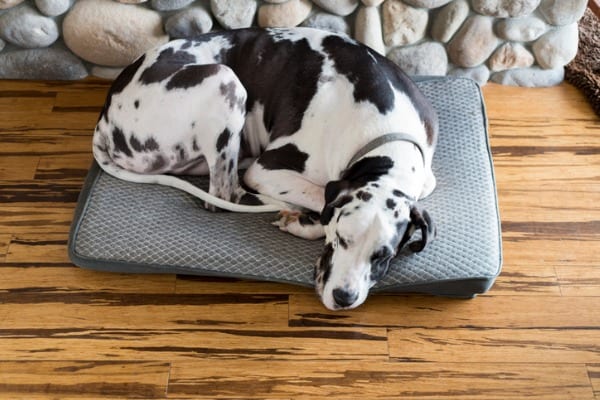
It also is slightly more water-resistant and durable against stains than hardwood.
Think about this:
What does that mean if you have bamboo flooring and dogs?
Because if you have dogs, you know the occasional accident happens, no matter how well your pet is trained.
The steps you take to protect bamboo flooring from pet urine aren’t complicated, but they are necessary.
Getting dog urine out of bamboo flooring is easier than removing urine stains from a carpet.
And it’s similar to getting dog urine out of tile floors should you ever be faced with that task.
However, there are some things you can do when cleaning urine off of a bamboo floor.
You need help:
Bamboo flooring and pet urine is a messy situation, but a DIY approach won’t cut it here.
A gentle approach and some natural cleaning products are the two things you’ll need the most to get dog urine out of bamboo flooring.
Bamboo…A Special Case with Pets
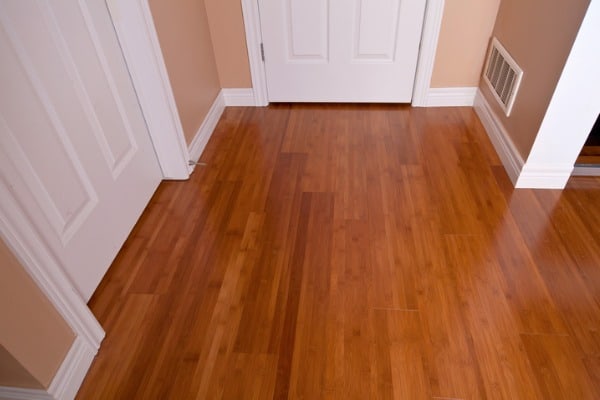
Bamboo flooring isn’t exactly waterproof – unless you’ve applied a waterproof sealant to it.
However, it’s better at repelling liquids and stains than hardwood floors that can get soaked with dog urine.
A urine stain on any kind of wood, whether it’s a floor or wood furniture, needs to be cleaned up as soon as possible, as set-in stains can become a tricky issue to tackle.
Old stains on bamboo flooring can cause discoloration. Since bamboo flooring is naturally light in color, stains will be more visible.
And what’s more…
Urine stains can also cause odors that will plague your house until they’re treated properly.
Moisture and humidity, or heat, can reactivate the ammonia in urine particles that are responsible for smells.
Unless you neutralize the smell entirely, it will continue to emerge and be a bother.
It’s not just you who is smelling it, either.
Your dog might be attracted back to the same spot, and the smell can even encourage them to urinate there again.
This is where an enzyme cleaner can salvage your floor – and your sanity.
Enzyme cleaners work on fresh and old stains alike and are truly the best dog urine remover available.
The good bacteria in enzyme cleaners break down the urine on a molecular level, thereby destroying the smell and stain at the source.
While dog urine could be more harmful humans, an enzyme cleaner also safe to use around people and pets.
There are no strong fragrances or chemicals to worry about when using enzymes.
My favorite product that is beyond helpful when your floor needs more than just a wipe with a mop is:
Most floors won’t react poorly to an enzyme cleaner.
It is, however, advised to do a small spot test somewhere inconspicuous before you treat a larger stain
Follow These 3 Steps to Remove Urine from Bamboo Flooring
What will you need to clean a stubborn spot from bamboo?
Some absorbent cloths or old towels, enzyme cleaner, and a spray bottle if your cleaner came in a jug, all of this and some time and patience.
For bamboo floors, stick to soft fabrics for cleaning up urine or any other liquid. Avoid anything abrasive as bamboo is more susceptible to scratches.
That and fabrics can be washed in a washing machine after use.
Step 1: Absorb the Urine
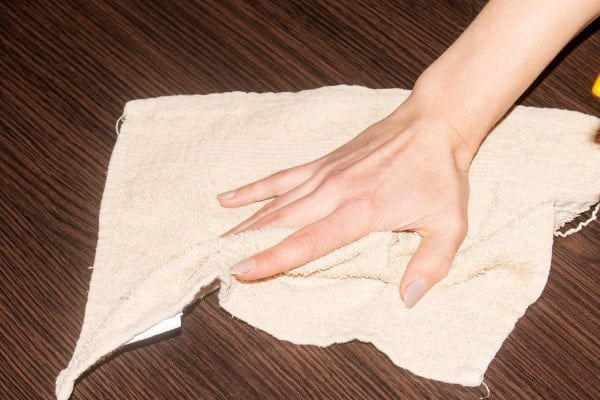
The key is to blot and dab to get the urine soaked up rather than scrub it.
Rubbing too hard can work the stain in even deeper.
You might need several dry cloths to get the area dried, but it’s worth the extra effort to get all of the liquid soaked up before treating the spot.
Some flooring types benefit from having a layer of baking soda on top of the urine spot – it can help draw out any moisture you missed with the cloth.
However, I do not recommend you use this step on bamboo floors.
The abrasive nature of the baking soda can cause small scratches and open up more avenues for urine smells to soak in.
If you can lift the bamboo flooring, in the case of a bamboo mat, you should also place a rag under the mat to help the area dry.
Step 2: Treat with an Enzyme Cleaner
Spray bottles are best when it comes to applying enzyme cleaner.
Some come in a bottle with a sprayer, but if not, it’s a good idea to purchase an empty one because it’s a worthwhile investment at a low price point.
Using a spray bottle allows you to coat the affected area evenly without accidentally pouring too much out.
Make sure you have the sprayer with a “mist” setting – it’ll give you an even layer of coverage while using this product.
Step 3: Let it Set
For old stains, enzyme cleaners work best if you leave the cleaner to sit overnight before wiping up any excess residue.
On fresh stains, letting the enzyme cleaner sit for a few hours rather than overnight gives it enough time to neutralize any ammonia and clean up the stain.
Preventive Advice
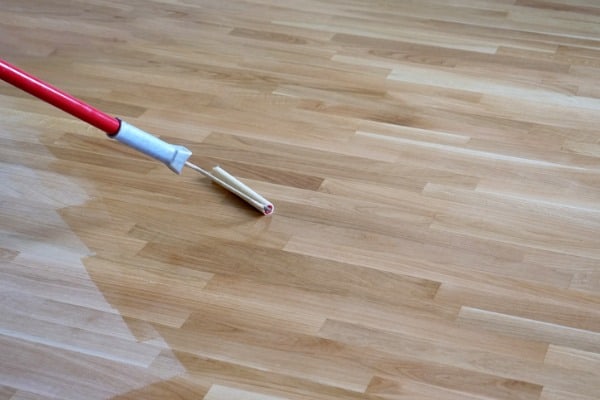
I recommend sealing or “finishing” the floor to protect bamboo flooring from pet urine.
Not only will it protect against liquids, but it will also make the bamboo more resistant to damage.
Even if you’re not worried about your dog peeing inside your home, those toenails can damage a bamboo floor.
Aside from putting boots on those pretty paws, a sealant on your floor is the best way to add to the longevity of your floors.
Sealing a floor isn’t as complicated as it sounds. You can, of course, hire the pros to do it.
Alternatively, you can DIY it with a sealant purchased from a hardware store or online.
While it’s true bamboo is a little more stain-resistant than other types of wood, the light color makes a stain noticeable if it does have a chance to set in.
Enzyme cleaners are good at getting stains out of many surfaces – but wood can be tricky because of its porous nature.
If you’re concerned about a particular area of the bamboo floor, it can save a lot of stress to put down an area rug as an extra barrier.
Like sealant, it will shield the floor from stains and scratches – things that come with dog parenthood.
Other Considerations
A Note on Bamboo Where Pets are Involved
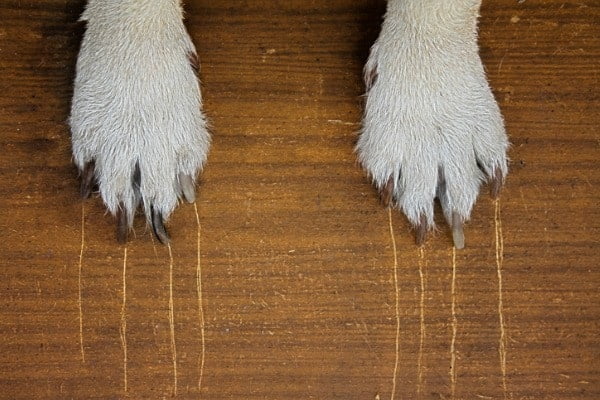
Regarding the softness of bamboo flooring – scratches can happen very easily.
Because of this, bamboo won’t make the best flooring in a room frequently visited by dogs and puppies.
If you’re in the middle of remodeling, save the bamboo flooring for areas where your dogs don’t usually go.
If you already have bamboo flooring, beware of puppy and adult dog nails.
You might find the floors need to be refinished more than once a year just from your dogs walking on them regularly.
Dogs running or playing on bamboo or wooden floors will expose your floors to more visible wear and tear than linoleum, tile, or carpeted floors.
Enzyme Cleaners – Not Just for Wood
Enzymes are powerful things: They don’t stop at wood surfaces when it comes to eliminating odor.
They’re effective on carpet, upholstery such as urine stained couches, tile, plastic kennels, concrete with pet stains such as patios and garages, and many more places you might need to treat for urine smells or odor in general.
Other organic stains can also be treated with enzymes, such as spots left behind by vomit or blood.
FAQs
Do Enzyme Cleaners Have a Fragrance?
Most brands do not have a distinct smell. Some have natural oils added to them.
In general, the scent of an enzyme cleaner is very light or nonexistent.
They are not designed to mask odors with artificial fragrances because they’re so good at eliminating odor-causing substances.
Will Spraying the Floor with an Enzyme Cleaner Warp It?
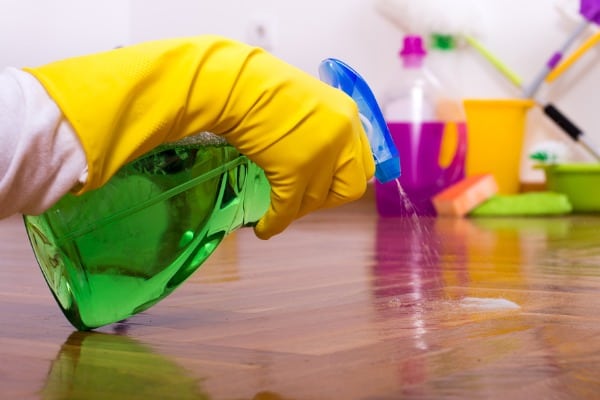
I strongly recommend doing a spot test with an enzyme cleaner before treating a large area with it.
Different flooring materials will react differently depending on age, previous care, and the environment.
If you already have a urine stain on your wood floor, it’s not going to make things worse by using an enzyme cleaner.
At the very least, the smell will be eliminated.
Should I use a Steamer with the Enzyme Cleaner?
Using a steamer or steam mop is an unnecessary step that can worsen the issue.
Heat will cause the bamboo to expand, so there’s a chance that the urine will soak deeper into the floor. In the worst case, you don’t want dog urine to soak down to the subfloor, either.
On bamboo, the mop can cause scratching. It can also spread the urine to a larger area and require more work on your end.
It’s more effective to clean the urine puddle with a cloth and treat the spot with enzyme cleaner afterward.
High heat can also render the enzymes ineffective.
Protect Your Floors
Bamboo flooring is a delicate surface that presents challenges when it comes to cleaning. Because of this, prevention is essential.
Bamboo flooring and pet urine aren’t the best of friends.
When you also throw in damage from the nails of various furry critters, it further complicates things.
The potential for scratching takes some common cleaning options off the table, such as baking soda or abrasive cloths.
If an accident does occur, don’t lose hope. Enzyme cleaners can be a powerful tool for getting rid of urine stains on bamboo and a variety of other flooring materials.

